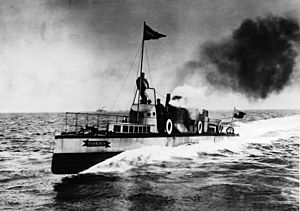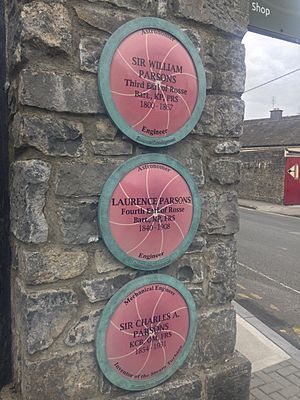Charles Algernon Parsons facts for kids
Quick facts for kids
Charles Algernon Parsons
|
|
|---|---|
 |
|
| Born | 13 June 1854 London, England,
United Kingdom of Great Britain and Ireland |
| Died | 11 February 1931 (aged 76) Kingston Harbour, Colony of Jamaica
|
| Nationality | Anglo-Irish |
| Citizenship | British subject |
| Alma mater | Trinity College, Dublin St. John's College, Cambridge |
| Known for | Steam turbine |
| Spouse(s) | Katharine Parsons (née Bethell) (m. 1883) (d. 1933) |
| Children | Rachel Mary Parsons (1885–1956) Algernon George Parsons (b. 1886–1918) |
| Awards | Rumford Medal (1902) Albert Medal (1911) Franklin Medal (1920) Faraday Medal (1923) Copley Medal (1928) Bessemer Gold Medal (1929) |
| Scientific career | |
| Fields | Engineering |
| Institutions | Heaton, Newcastle |
Sir Charles Algernon Parsons (born June 13, 1854 – died February 11, 1931) was a brilliant Anglo-Irish engineer. He is most famous for inventing the steam turbine. This amazing invention changed how we make electricity and how ships travel. Parsons also designed special equipment like searchlights and telescopes. His work had a huge impact on both naval ships and the way we generate electricity.
Contents
Early Life and Education
Charles Parsons was born in London, England. He was the youngest son of a famous astronomer, William Parsons, 3rd Earl of Rosse. His family lived in Birr Castle in Ireland. The town of Birr was even called Parsonstown for a long time, after his family.
Charles and his three brothers were taught at home by private tutors. These tutors were very good at science and helped his father with his astronomy work. One of them later became a famous astronomer himself. Charles then studied mathematics at Trinity College, Dublin and St. John's College, Cambridge. He finished his studies in 1877 with top honors.
After college, Parsons became an apprentice at an engineering company called W.G. Armstrong in Newcastle. This was unusual for someone from an earl's family. Later, he worked at Kitsons in Leeds, where he helped develop rocket-powered torpedoes.
Inventing the Steam Turbine
In 1884, Parsons joined Clarke, Chapman and Co., a company that made ship engines. He became the head of their electrical equipment team. Here, he invented his first steam turbine engine in 1884. He quickly used this new engine to power an electrical generator that he also designed.
Parsons' steam turbine was a game-changer. It made it possible to produce electricity cheaply and in large amounts. It also completely changed how ships were powered, making them much faster. Before Parsons, another type of steam turbine existed, but it couldn't produce much power. This was because the materials available at the time weren't strong enough to handle the forces. Parsons' design was different and much more effective.
Starting His Own Companies
In 1889, Charles Parsons started his own company, C. A. Parsons and Company, in Newcastle. This company built turbo generators based on his designs. In the same year, he also set up the Newcastle and District Electric Lighting Company. In 1890, this company opened the Forth Banks Power Station. This was the first power station in the world to use turbo generators to make electricity.
Parsons kept improving his turbine. His first turbine was not very efficient, but he made rapid improvements. By 1899, he built his first megawatt turbine. This powerful turbine was used in a generating plant in Germany.
Turbines for Ships
Parsons was also very interested in using his turbines for ships. He started another company called the Parsons Marine Steam Turbine Company in Newcastle.
A famous event happened in June 1897. Parsons' turbine-powered yacht, the Turbinia, showed up unexpectedly at a Navy Review. This review was for Queen Victoria's Diamond Jubilee. The Turbinia sped through the water at an amazing 34 kn (63 km/h; 39 mph). At that time, the fastest Royal Navy ships could only reach 27 kn (50 km/h; 31 mph). This showed everyone how powerful and fast his new turbine technology was.

Within two years, the Royal Navy launched two destroyers, HMS Viper and HMS Cobra, both powered by Parsons' turbines. Soon after, the first turbine-powered passenger ship, TS King Edward, sailed in 1901. Then came the first turbine transatlantic liners, RMS Victorian and Virginian, in 1905. In 1906, the famous battleship HMS Dreadnought was launched, also using Parsons' turbine engines. The Turbinia can still be seen today at the Discovery Museum in Newcastle.
Achievements and Legacy
Charles Parsons received many honors for his work. He became a member of the Royal Society in 1898. He was awarded the Rumford Medal in 1902 and the Copley Medal in 1928. He was also made a Knight in 1911 and became a member of the Order of Merit in 1927.
Parsons' turbine company is still active today. It is part of Siemens, a large German company, and is located in the Heaton area of Newcastle. In 1925, Charles Parsons also bought the Grubb Telescope Company and renamed it Grubb Parsons. This company made telescopes until 1985. Parsons even designed an early type of gramophone that used compressed air, called the Auxetophone.
Personal Life
In 1883, Charles Parsons married Katharine Bethell. They had two children: a daughter named Rachel Mary Parsons (born 1885), who also became an engineer, and a son named Algernon George Parsons (born 1886). Sadly, their son Algernon died during World War I in 1918.
Sir Charles Algernon Parsons passed away on February 11, 1931, while on a cruise with his wife. He was buried in the church of St Bartholomew's in Kirkwhelpington, Northumberland.
His wife, Katharine, and daughter Rachel, along with other women, started the Women's Engineering Society in 1919. This organization still exists today and supports women in engineering.
Remembering Charles Parsons
At Parsons' family home, Birr Castle in Ireland, there is a museum. It shows how much the Parsons family contributed to science and engineering. A part of the museum is dedicated to Charles Parsons' engineering work.
In 2017, a special Irish silver coin was made with Charles Parsons' picture on it.
The Irish Academy of Engineering gives out "The Parsons Medal" every year. This award is named after Charles Parsons and honors an engineer who has made an amazing contribution to engineering.
Selected Works
- E-book: "The Steam Turbine and Other Inventions of Sir Charles Parsons"
- The Steam Turbine (Rede Lecture, 1911)
Images for kids
See also
 In Spanish: Charles Algernon Parsons para niños
In Spanish: Charles Algernon Parsons para niños




